| | | | | |
Posted on : Jan 03, 2013
RADIO SAI STUDY CIRCLE – 8
SOS: Swami On Sadhana
SOS: Swami On Sadhana
Welcome to another episode of the Radio Sai Study Circle. This is the 8th episode of this series which was started in September 2010. These episodes have been a very educative and elevating experience for all of us participating in this programme and we thank Bhagawan for this opportunity.The greatest inspiration for us has been your positive feedback on all our previous episodes. This is what our readers had to say on the previous episode which was on the theme Liking Swami verses loving Swami.Dr. Sarika Jain (New Delhi): 'The discussion was truly revealing in the sense that we realized how inauthentic our devotion is for Baba as it is limited to merely obtaining happiness for ourselves through His worship. You have strongly brought out an invaluable message through the discussion, and that is to love Him one must follow His teachings and that should transform the person. And now I am left contemplating do I really love Swami?'Ms. Poornima Srinath: 'This session made me understand that when the word 'love' becomes a verb in our lives it automatically leads to surrender and surrender ultimately leads to oneness with God'.Ms. Akila Sitaram (Bangalore): 'You have hit the nail on the head on practical issues. Imagine the revelation it can cause if only we transform the way Swami expects us to.'Ms. Jyothi Ramchandra: 'It was one of the best study circles I have heard. You discussed the heart of spiritual life which is practicing the teachings of the Master. It helped me to refocus on Baba'.Ms. Asha Nigum: 'You are really conveying the message through excellent anecdotes. It is like reading a story with deep message but conveyed with fun and ease, do include more and more of His teachings in your programme'.The current study circle is on the theme: Swami on Sadhana (SoS). The participants of this edition are Radio Sai's Bishu Prusty (BP), and three research scholars from Baba's university, Amey Deshpande (AD), Sai Giridhar (SG) and K. M. Ganesh (KMG). The panel is moderated, as always, by Dr. G. S. Sri Rangarajan (GSS), who is the Controller of Examinations, Sri Sathya Sai Institute of Higher Learning.
PART 01
GSS: Welcome Bishu, Amey, Ganesh, and Giridhar. Sai Ram to all of you! So what's today's topic? SOS! Save our Soul? Yes. But in our context, it means Swami on Sadhana.
Today we will be using anecdotes of Bhagawan, small but profound analogies given by Baba, such as "Hands in the society and heads in the forest". Spirituality, in a very practical way, is all about being in the society and doing your duty, but internally being anchored in God.
AD: Being in the world, but not of the world.
AN INTRODUCTION TO SADHANA
GSS: That is correct. Not of the world. This is what we will talk about today. Swami on Sadhana – SOS! We'll start with introduction to Sadhana.
But first let's understand what an analogy is. Swami says that when a small child cries without eating food, his mother cajoles it saying, "Look, look here, look at the moon". She points out to the moon. The child looks at the sky with his mouth agape. The mother places a morsel of food in his mouth. Then she points out to a branch and says, "Do you see the moon over those branches?" But where is the tree branch and where is the moon? They are miles and miles apart. Bhagawan says even analogies should not be stretched too far trying to analyse and look into the nitty gritty. We need to grasp the message from these examples.
BP: They are just a tool - a medium.
SG: Yes. In fact every tool has its unique use. What a screwdriver does cannot be done by any other tool.
BP: Yes
 |  |  |  |  |  |  |  |
SG: In the same way, every analogy has its role to perform.
BP: You are correct.
GSS: Giridhar, what is Sadhana? What does Bhagawan mention about Sadhana?
SG: Before we get into the subject, I would like share a unique experience that almost every devotee who comes to Prasanthi Nilayam experiences.
AD: What is that?
SG: As devotees drive towards the ashram from the railway station, their cars are often chased by stray dogs.
GSS: I have heard about that…
BP: When man comes in search of God, Dog chases man!
SG: Yes. Devotees come chasing God and dogs chase devotees! Bhagawan gives the most profound meanings to the simplest of everyday events in a sweet way to all of us. These dogs chase cars that are moving much faster than them – and would probably never catch up. Even when you stop your car, these dogs would give you a quizzing look as though to ask, "Why have you stopped?" They do not know why they chase the cars. Doesn't man too run after this world without perspective? Sadhana is all about giving that right direction and perspective to man.
BP: Very true Giridhar.
SG: Swami also used to give an example of a panting dog. He would look at a panting dog and tell us, "Look at this dog. It has run hither and thither without knowing where its goal is. It is restless running around and pants as though it has done a lot of work". Swami says Sadhana should not be like that. Sadhana is not labour. It is not about aimless wander. The goal of Sadhana is God, the goal of Sadhana is Love. Swami always says that God is bhavapriya, He looks at the feeling behind the activity.
KMG: One should not lose the spirit.
AD: We will soon start running around. In fact, starting next Tuesday, we will begin Grama Seva. At the end of the day, we would have run around so much! But would we have really understood the message behind Grama Seva?
GSS: Sadhana is more of an internal than external practice.
GSS: Sadhana is more of an internal than external practice.
 |  |  |  |  |  |  |  |
BP: Yes. The world today is full of people running around. Look at today's generation. Youngsters think it is unfashionable to think of God, to sit and meditate even for 5 minutes! They think it is all very ancient.
GSS: Old style.
BP: Yes, but what we do not realise is that it is the most beautiful thing to do because it can fashion your life so beautifully. This is something which can actually bring happiness that is lacking in life. Bhagawan used to comment on how we do not view our ancient practices and spiritual Sadhana in the right perspective; He used to state the example of offering ghee and other items into the sacrificial fire which people laugh at and say it is waste of food material. Baba says it is as if saying the farmer who sprinkles seeds on the ground is a fool. What they do not realise is that what you offer to the earth, you actually get back ten times more.
When Bhagawan explains this with such an example it becomes easy for a youngster to appreciate the importance of our ancient practices.
Regarding Sadhana, many people are confused about the path to follow. They say that there are multiple paths – Karma, Bhakti and Jnana (Paths of Action, Devotion and Wisdom). Bhagawan has beautifully said that there are no separate paths. One cannot truly differentiate one path from the other.
| | 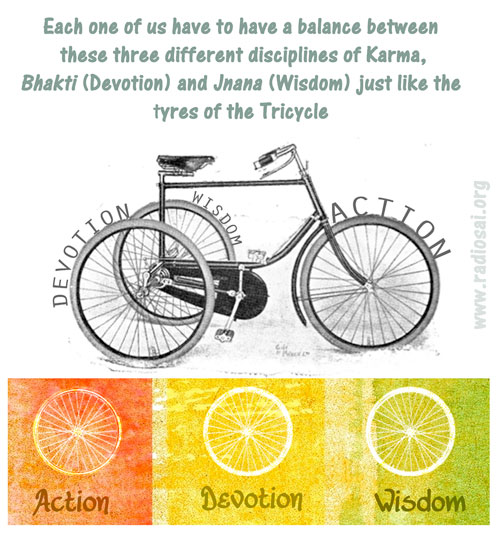 |
AD: I remember Swami comparing the three paths of Karma, Bhakti and Jnana to the three wheels of a tricycle or auto rickshaw. You need all the three wheels for the vehicle to move. You cannot say that one wheel is more important than the rest. However, you need one wheel to guide the other two wheels. Each one of us have to have a balance between these three different disciplines of Karma, Bhakti and Jnana. It's just that the importance we give to one path may be more than the other two. This differs among individuals.
GSS: The ratio is different.
AD: Yes. For some Bhakti is predominant. That is the wheel that guides their vehicle. So we really cannot say that one is purely a Bhakti Yogi, Karma Yogi or Jnana Yogi.
BP: Yes. In fact as you were talking about this example of the tricycle, I was reminded of this beautiful analogy about the Indian sweet Mysore Pak that Bhagawan used to use. Baba says that this particular sweet has three aspects to it - sweetness, weight and shape. Now you cannot really separate one aspect from the other. You cannot just have the sweetness and remove shape and weight. You have to take a piece of the sweet in your mouth and experience the sweetness with your tongue. The shape would melt in your mouth and the weight would reduce. In the same manner, Karma is Bhakti, Bhakti is Jnana - you cannot really separate them.
GSS: Yes, but as Amey says one path may be dominant for some people, while another path may be dominating for other - this ratio keeps changing.
BP: Yes
GSS: Sadhana is a very subjective and a very customised concept for every devotee. And the Master guides each one exactly on a very customised path which is meant for that particular individual.
KMG: Not just from devotee to devotee, but even for the same devotee.
GSS: Yes, at different points of time.
BP: Different stages of evolution.
GSS: In fact I recall a wonderful example that Bhagawan gave. Again He takes the mother-and-child instance. There was a mother with many children. One day all the children wanted juice, but one wanted red juice, another wanted yellow, yet another wanted green. What does the mother do when each child wanted a different colour?
The mother prepared normal lemonade and poured it in different coloured glasses – red, yellow and green. The children were happy that they got the juice in the particular colour they wanted. And this is what Swami exactly does! He gives us what we think we want, but in that is hidden the real Sadhana that is meant for us - He guides us on a very customised path meant for each one.
KMG: So one way of looking at it is that Sadhana should basically broaden our perspective.
GSS: Exactly
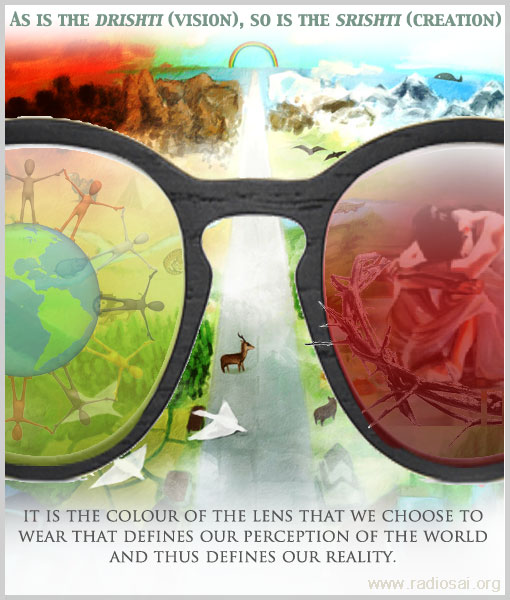 | |
KMG: I am reminded of a very popular Nepali song which sort of resonates this understanding.
SG: Please go ahead.
KMG: The meaning of the song is that if we view the world through the lens of a flower, the world would appear like a flower. Whereas if we view the same world through the lens of thorns, the same world will appear like a thorn. As is the drishti (vision), so is the srishti (creation). Bhagawan often says that it is the colour of the lens that we choose to wear that defines our perception of the world and thus defines our reality.
GSS: What we basically understand from this initial discussion is that Sadhana is necessary. Sadhana is what really brings us closer to God. Bhagawan always used to give the example of a bank account. He said that all the good that you have done in the past brings you closer to God, but at the same time He cautions us that all the bad that we have done in the past is also pulling us away from God. So we must constantly keep doing more and more good actions. It's like adding more and more money to your account otherwise at one point you will find yourself going overdraft. Therefore Sadhana is necessary.
Even before discussing about the process of Sadhana, let us talk about the prerequisites. Are there any prerequisites? One important thing is affinity – a feeling to come closer to God. We may call it attachment to God and detachment from the world. Unless one has this mindset, it would be difficult to think of doing Sadhana. Amey, what does Bhagawan say about getting attached to God?
RADIO SAI STUDY CIRCLE – 8
SOS: Swami On Sadhana
SOS: Swami On Sadhana
Part 02
PREREQUISITES FOR SADHANA
AD: I am reminded of one thing that Adi Shankaracharya says in Viveka Chudamani. He says that the three prerequisites that we need is Manushatvam, Mumukshatvam and Mahapurusha Samshrayaha. And what does it mean? Manushatvam is to be born as a human being - congratulations to us for that! Mumukshatvam is the intense desire to do Sadhana.
GSS: For liberation.
AD: Yes, for liberation. Guess what! As Sai devotees we have that too. Congratulations! And then we have this Mahapurusha Samshrayaha - that is, the guiding hand of a great soul. In fact, we have the Yuga Purusha (Avatar of the Age) Himself!
GSS: Yes! We have God Himself.
AD: God Himself! So congratulations again! It is Mumukshatvam that is the fundamental prerequisite of Sadhana. Swami often used to use the word JOY, especially during Christmas. Swami says J-O-Y stands for "Jesus First, Others Next, Yourself Last". This should be the hierarchy in which we should place all our activities in life - put God first then the rest of the world and ultimately, at the end of it all if there is anything left, yourself.
BP: In fact as we are talking about this attachment to God and the prerequisite for Sadhana, the most important thing is to get our goal right, which is getting attached to God. Swami gives a very beautiful example of a river. He used to refer to River Ganges and how it flows towards the ocean, going through twists and turns and bends and boulders, but never stops.. Even when it reaches the ocean, the ocean doesn't accept it easily. It takes a lot of effort and a lot of lashing before it merges into the ocean. I think that should be the kind of perseverance towards the goal. Swami also brings up the example of a train journey. If, for example, you are going to Delhi, you wouldn't get down at Jamshedpur. You may get down and go sightseeing, relax or shop, but you wouldn't seek a home in any of the other stations if your home is Delhi. Only when you travel with a focus that Delhi is the destination, will you persevere and reach the destination.
SG: In fact Bishu, there's another lesson from the river. It is so focused that even for a moment, it would not look behind to see how many boulders it had struck or overcome.
BP: It stops only at the ocean.
SG: Even if just a drop would have stopped and looked back, the river wouldn't have made it to the ocean.
AD: The river in fact gives several more beautiful lessons, which we can learn. It never looks at its own achievements. Hundreds of towns and cities are built upon its banks, but it does not feel anything because it is absolutely focused on its goal.
 |  |  |  |  |  |  |  |
GSS: All this reads well, but how do we develop detachment like the example Bishu was talking about. There is so much 'excitement' and 'joy' - how do we get detached from this? Swami provides a beautiful example. He says, "Don't have your focus on getting detached from the world, keep your focus on getting attached to God."
And He gives the example of a seesaw. He says when one side of the seesaw goes down, the other side automatically goes up. So if you start thinking of God, start loving God and make some place in your heart for God, then you will, like a ripe fruit that easily slips its skin, automatically get detached.
BP: Wow!
GSS: In the same way, Bhagawan says you will automatically find the world dropping away from your priority list and you come closer to God.
AD: In fact I am reminded of a very beautiful incident. During my 8th standard, I used to write letters to Bhagawan in which I address Him as 'Dearest Bhagawan'. Once He took my letter and read the words 'Dearest Bhagawan'. Then He said, "Dear-rest." I still keep contemplating the way He said those words – "Dear Rest". And the way He said it seemed as if He wanted to say, "You simply call Me dear, but the rest of the world is in your heart".
AD: In fact I am reminded of a very beautiful incident. During my 8th standard, I used to write letters to Bhagawan in which I address Him as 'Dearest Bhagawan'. Once He took my letter and read the words 'Dearest Bhagawan'. Then He said, "Dear-rest." I still keep contemplating the way He said those words – "Dear Rest". And the way He said it seemed as if He wanted to say, "You simply call Me dear, but the rest of the world is in your heart".
KMG: Rest of the world is dear to you.
AD: From that day onwards I stopped using the word 'Dearest' and I used to write 'Most Beloved'. And even for that Swami said "Be-Loved." Be loved by God and attach yourself to God.
KMG: Beautiful!
SG: This could also mean that if you're dear to God the rest will be taken care. In fact Swami also puns with the word 'Friendship'. He says friendship is like a ship. If you do not have the right kind of friend, like someone who is more interested on the size of your pockets, the friendship will not sustain.
| |  |
Nowadays we have social network friends, such ships (friendship) will take you to the middle of the ocean and sink right there. Those kinds of friendships are of no use at all, the true friend, Bhagawan says, is God. God is your only friend. And He's such a ship that even through the worst of storms, will take you across and land you in the safety of Liberation over this ocean of samsara (worldly existence).
Swami also used to say that many people are excited or feel proud to say that his or her friend is a politician or is in a good position or is rich. Just consider for a moment, if you consider God Himself as your friend how much more proud you will feel and how much more secure you would be!
BP: How much more secure you will feel actually.
SG: I mean you have the Lord of the Universe, the entire Universe is His property and He is your friend.
KMG: Definitely, well just as we saw in the seesaw example, which gives us a quantitative equation that the attachment to God is universally proportional to attachment to the world. Bhagawan also gives a very qualitative analogy of applying the oil of faith in God before cutting or handling the jack fruit. The jack fruit here symbolises the world.
AD: You are correct.
KMG: Oil nullifies the effect of the sticky pigment that tries to stick on our hands, which makes it easier while cutting the fruit. Similarly if we were to enter the world and yet be unaffected by its pulls and attachments, we will have to apply the oil of faith in God before taking up any task. Be in the world but not of the world, as Bhagawan says. Faith in God is essential to cut all the bonds that bind us down.
GSS: So to wind up this round on attachment, we understand that getting attached to God is first priority which includes not just loving God the way we understand, but also to follow His words and message. Swami puts this beautifully in the form of an analogy. He says a patient who goes to a doctor is not just given medicines, the doctor also prescribes a diet for him.
BP: Yes
GSS: Unless you follow the diet along with the medicine you'll not really become healthy. So Bhagawan says loving God is the first step no doubt, but it is not sufficient by itself. That is the medicine. But to follow the message and the teachings of God is the diet. Both put together will take you closer to God. That is the first step in Sadhana.
So we have really seen very good examples in this module Amey shared about having Jesus first, others next and yourself last. We have seen the seesaw example that Ganesh mentioned and also about technique of not getting one's hands sticky by applying oil. Giridhar talked about how to have friend'ships' that won't sink. Bishu spoke about the single-minded focus of the river making its way to the sea. Amey also shared his experience with Swami and on Bhagawan's pun on the word 'Dear rest' - that rest of the people are dear but not you. Finally we talked about Swami's analogy on how medicine and diet, love for God and following His message, are equally important.
But in truth, don't you think this is much easier for us because we are here in this serene ambience of Prasanthi Nilayam, where everyone thinks in this manner. We have heard many devotees and our own students who live across the world say that it is easy in Prasanthi Nilayam, but difficult in the outside world, which, as Bishu referred to, is like a rat race. So don't you think the type of company you are in also makes a lot of difference?
BP: A huge difference.
RADIO SAI STUDY CIRCLE – 8
SOS: Swami On Sadhana
SOS: Swami On Sadhana
Part 03
GOOD COMPANY – ANOTHER PREREQUISITE FOR SADHANA
GSS: What does Swami say about the importance of good company?
SG: Swami used to say, "Tell me your company and I shall tell you what you are".
AD: I think that's a very important prerequisite to Sadhana. An example that comes to my mind is Swami talking about dust and the wind. When dust is company of the wind, it rises up and achieves great heights. But the same dust, when it comes in company with water settles down.
SG: It becomes slushy.
 |  |  |  |  |  |  |  |
AD: Using the example of dust, Swami beautifully explains the impact of company.
SG: Swami also used to give the example of paper. A newspaper by itself doesn't have any fragrance of its own, but when you wrap a beautiful jasmine garland with it, the newspaper acquires the fragrance of the flowers. And when you use it to wrap dry fish, it would get the smell of dry fish and would continue to emanate the stench even after the fish has been removed.
GSS: Possibly for a longer time than the jasmine flowers.
BP: I am reminded of an incident that happened with Bhagawan during His trip to Kodaikanal. Bhagawan used to travel by car and the students who accompanied Him travelled in a bus that followed His car. After sometime, Swami would come and join the boys in the bus. But people on the road would continue to offer salutations to the car thinking that Bhagawan was travelling in it. Bhagawan pointed this out to the students and said that even though He was not physically present in the car, it continued to receive adulations from people because of its association with Him – it had God as company.
GSS: And very humorously Swami extended that example a little more. He said, "Now I am sitting with you students. See, nobody is offering Namaskar to me. I am in your circle of influence."
BP: Swami also gives the example of iron and magnet where God is the magnet and man is iron. Swami says man should naturally get attracted to God because man is also divine. However, as the iron is covered with rust it does not get attracted to God. We should remove the cover of rust through Sadhana. Swami says laziness is rust and dust. We have to make efforts to be in good company to get it off this rust.
| |  |
KMG: In fact when we talk about company we generally look outside. Swami says it's not just about looking outside - you have to look within yourself because we are a combination of many qualities - good and bad. Swami here gives the example of milk and curd.
Some people may think that if they are 95% of the time good and maybe 5% of the time not good, they may go off the track either because they don't have the strength to control their vagaries of mind or they feel 100% commitment is humanely impossible.
If an entire garden is full of flowers, one may fail to notice a few patches of weeds here and there. Similarly a Sadhaka may become complacent while weeding out seemingly negligible bad qualities inside his heart. But Bhagawan warns that this analogy does not work in spirituality. He says that if there is even a little bit of curd in the pot, even if you put many litres of milk in the pot, over night the entire pot of milk will turn into curd. That is the reason why many spiritual aspirants are often found complaining that despite singing bhajans and chanting Vedam every day, they don't seem to find deep connection with Bhagawan. Why? This is because he or she has not given up certain traits or unpleasant qualities which are like a spoon of curd. And Bhagawan, like a Divine Mother, is waiting patiently to pour the divine milk of love and grace. If only the individual with a little effort cleans the pot!
BP: Yes
SG: In fact, Ganesh, it is also said that just one drop of poison is enough to poison the entire pot of milk.
KMG: That is correct.
BP: It is important to have good friends as one's company. Bhagawan says that a tame elephant can immobilize and bind a wild tusker, similarly a spiritually minded person also can turn around a doubter.
GSS: I think there is no end to the number of examples.
GSS: I think there is no end to the number of examples.
KMG: Nobody is perfect. But we have to put effort to improve. In fact, effort is more important than the result.
 | |
GSS: In this section, we have seen the importance of good company and have used many examples to drive home the point - dust and water, a newspaper that covers fresh jasmine and dry fish, iron and magnet, and the example of curd and the milk.
Ganesh, Swami also gives the example of water and milk. If you add one glass of water to 99 glasses of milk, the water will also become milk. This is like joining good company. However, if you add one glass of milk to 99 glasses of water, the pure milk also becomes water. This is like joining bad company. That's why He says, "A-B-C - Avoid Bad Company".
The next topic under Sadhana is the process. When you talk of Sadhana the first thing that comes to our mind is what Bhagawan says. In Kali Yuga, the easiest Sadhana one can do is Namasmarana, chanting the name of God, not yagnas and yagas (ritualistic sacrifices).
THE PROCESS OF SADHANA
AD: Swami gives a beautiful example. Decades ago, villagers used to light lanterns and place them on the threshold of their homes. By placing the light on the doorstep, it would provide light both indoors as well as outdoor. He says chanting the name of the Lord is like keeping that lantern on the threshold of one's self. It sheds light not only inside, but outside as well.
GSS: The threshold here is one's mouth.
AD: Swami says that the mouth is very important - it's the threshold of the entire body. It connects the inside with the outside.
KMG: Namasmarana is not something that can be done part time. It has to be done continuously because life is one long journey and every one of us is a sadhaka, a spiritual aspirant. Some people fail to see the path of spirituality. They choose to sleep. They say that they are scared to walk as the path has no light. At any given time it is only the next few meters that one needs to see and for that even a small lamp is enough to give the confidence to move forward - provided one has the will to move forward. This light is Namasmarana. When we chant His name we get the clarity to see and move forward. Being spiritual aspirants we have to trust the Name and take one step at a time - we will definitely reach the goal.
SG: Swami gives another reason why Namasmarana is very important for all of us. Mind, Swami says, can be a "monkey mind", sometimes a "drunken monkey's mind", sometimes the "mind of a drunken monkey bitten by a scorpion".
GSS: A mad and drunk monkey bitten by a scorpio!
| |  |
BP: It can't get worse than that!
SG: What it basically means is that the vagaries of the mind have no limits.
BP: Absolutely!
SG: And it can go to any extent. So Swami always used to compare the idle human mind to a genie or a demon that is waiting to devour you if you do not engage in some work or the other. An idle mind is the devil's workshop! Swami says the best way to engage this genie called the mind is to erect a pole and ask the mind to climb up and get down until you have some work for it to do. He says that the pole is the beautiful form of the Lord and the process of climbing up and down the pole is the process of doing Namasmarana.
BP: Regarding Amey's example on power cuts, I am reminded of another beautiful anecdote that Bhagawan used to give concerning this issue. Swami used to say that when electricity enters our homes from power stations it comes passing through several electricity poles - it doesn't come straight from the power station. It has to come through many small sub stations. And then you have all these poles stationed at regular intervals. Swami says for you to access electricity it has to come through all these poles stationed at regular intervals. Similarly for you to get recharged, for you to tap into the power that is God and obtain His grace, some kind of regular Sadhana is necessary. And what is the best Sadhana? Namasmarana.
GSS: In fact that's what Swami says. Namasmarana is the hot line to God. However, just as with our networks we find that there is no connectivity. The reason, Swami says, is because the connection is not constant. He gives the example of a chain highlighting how every link in the chain is important to keep the chain intact. If you give up Namasmarana for sometime it's like breaking the chain; you would have to start again. Therefore constantly keeping Him in the mind is what really keeps up this hotline connection.
We have seen many examples with regards to Namasmarana. We have heard how beautifully Swami says that the mouth is like the doorstep and the light should be lit on that so that it lights both inside and outside. Ganesh talked about taking the light with oneself so that at least the next few feet is visible and one can keep moving onto his/her goal. Giridhar talked about the genie and keeping the divine form as the pillar and engaging the mind on that. Bishu shared Swami's example of the electricity poles and the chain, and how it is important.
But Sadhana does not stop with this. Swami has time and again reminded us that this is just the first step. Ultimately one needs to seek Swami within each one because God is not someone outside us but is someone within us.
Now let's discuss about the higher Sadhana which is about seeking God within.
RADIO SAI STUDY CIRCLE – 8
SOS: Swami On Sadhana
SOS: Swami On Sadhana
Part 04
HIGHER SADHANA – SEEKING GOD WITHIN
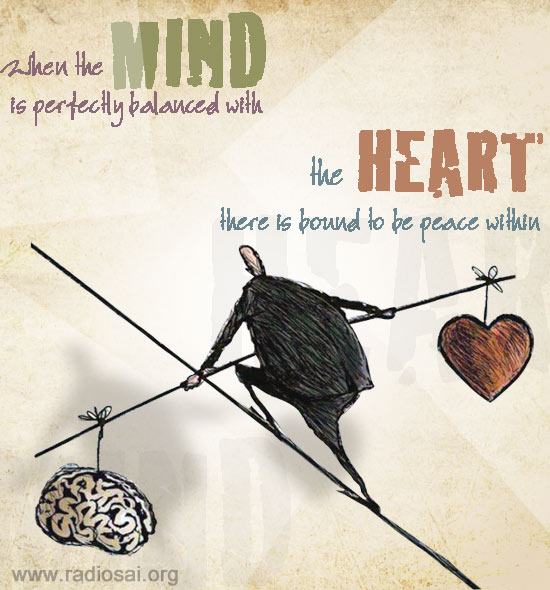 | |
SG: I remember a beautiful event that happened in 1999. The institute's MBA students were seated at Sai Kulwant Hall and were praying to Swami for a group interview. And they all said, "Swami, please give us an interview. Please give us an interview." Swami replied with a smile, "Wife lekhe aao, interview dehta hai (Get your wife and I will give you an interview)".
GSS: Everybody would have had a good laugh.
SG: They laughed thinking that Swami is joking and continued with their pleading. As Swami started walking away, He stopped for a moment, turned and said, "Boys, did you not understand what I said just now?"
Then He drew a beautiful analogy. He said, "Your mind is your wife, the Atma is the husband. When the mind is in perfect tune with the Atma, it has perfect understanding with your conscience and there is peace and harmony at home which is our own self, our body. But if the mind and Atma go in two different directions…" Swami punned with the word and said, "The result will be diverse".
Swami did not disagree for an interview, but He was giving the boys a much more important message. Swami was stressing on the important message that 'inner view' was more important than an interview! And to get that inner view the mind has to be in tune with the Atma, which is inside us, which is the very core of our being.
BP: Beautiful!
AD: You would have observed that throughout Swami has presented to many devotees and students different types of diamond rings – green diamonds, white diamonds, three diamonds, six diamonds and so on.
GSS: Haven't we watched those fingers!
SG: We used to call it a grand slam!
SG: We used to call it a grand slam!
AD: Yes. Swami used to pun with the word 'Diamond' too. He said, "Diamond actually means 'Die Mind'". That is when you are able to shut your mind or crush your mind completely - it becomes as precious as a diamond. Just as a diamond sparkles in light, if you cut your mind, the inner self will sparkle forth.
SG: To give more clarity on what is to end the mind, Swami says, "See, we have thousands of thoughts running in our mind. Through Namasmarana focus it on one thought first."
GSS: One needs to channelize it.
SG: And after sometime even that one thought has to be relinquished and that is really the end of the mind. In that absolute nothingness the mind is like a mirror that reflects the light of the Atma.
AD: Many to one and one to none.
KMG: When we talk about mind, there's one more analogy that comes to my mind. Most people tend to blame God. They say, "God, you have created the world, and all this maya is your making. So why are we trapped?"
Once a devotee addressed Bhagawan as Maya Swaroopa (Embodiment of Maya). Swami immediately answered, "No, I am not Maya Swaroopa, I am Jyothi Swaroopa - I am the Embodiment of Light." Swami said that one should not blame the sun for the shadow. The shadow is formed due to the object. The object is one's mind. The entire Sadhana is all about nullifying the mind. The moment you nullify the mind you have reached the goal.
BP: Talking about nullifying the mind and purifying the inner self, I remember a very beautiful analogy that Swami provides on this topic. He said that when you are drilling the ground fixing a pipe to draw water, you have to ensure that no air or water gets into the pipe because vacuum is necessary to draw water. Swami said our inner self is like that. Our outer self should not in any way contaminate the inner self. Only when we do not allow the outer self to influence the inner self and keep the inner self clean can we really connect and go inward.
GSS: Swami also advices not to dig shallow borewells because you really won't reach God. Rather dig just one borewell and reach right to him.
 | |
KMG: That's why we are told to focus within. This means that all the contamination and delusion is outside. Swami says when you are sitting in a train and look outside at another train that is running parallel to your train, it would seem that your train is stationary while the other is moving. Swami says that is maya. What is the solution to overcome this? Look into your train - look within.
SG: When a thorn pricks your foot, you would not merely sit. You would try to remove it.
KMG: Yes. Get rid of it instead of analysing the intensity of pain.
GSS: And the solution to that is only one and that is Sai.
KMG: Sai?
BP: Yes.
GSS: SAI means See Always Inside. You travel miles and miles across various places and through various means to visit a temple. As soon as you see the idol of the Lord you close your eyes because, by instinct, the mind knows that it has to see God within. Swami gives a very beautiful example in this regard.
A bird is sitting high on the branch of a tree that is violently shaking due to a huge storm. But the bird is calm and does not move. One would wonder as to how the bird is so calm despite the storm. And then suddenly the branch breaks. What would happen now? The bird just flies away. The bird's equanimity is because it depended only on its wings. Though it appeared to be sitting on the branch, the branch was not its basis. The wings were its basis. In the same way if our true self or the Atma is what we are anchored in though we live in the world, we will remain unruffled because we will look within. So looking within is really the key and that is the goal of Namasmarana.
Let us take up a few examples of what does surrender really mean or at what point can we say that we have really surrendered to God.
SURRENDER – THE FINAL GOAL OF SADHANA
SG: Speaking about surrender, I would like to share an experience that I have had. Bhagawan had once given a student an opportunity to ask a few questions.
One of our brothers had asked Swami, "What is surrender?" Bhagawan answered through a beautiful analogy. He asked all of us, "How many of you know how to drive a car?" A few of us raised our hands.
He then asked, "How many gears does a car have?" We said, "Swami, it has four gears."
Swami said, "Do you know that life also has four gears?" He said, "The first gear is happiness, second gear is sorrow, third gear is happiness and fourth gear is sorrow".
 |  |  |  |  |  |  |  |
He said, "If you are in the neutral gear, the vehicle of life will go smoothly without much turbulence, but the problem comes when you are in any of the other gears - that is the gears of happiness or sorrow."
In fact, He went on to explain further, "Even when you are in the first gear you are going at a constant speed, do you feel any turbulence?" We said, "No Swami."
Then He asked us, "When does the problem arise?" We all said, "Swami, when we try to accelerate we have to move to the next gear."
He said, "What will happen if you directly move to the next gear?"
We said, "Swami, the car will jerk and might even stop if we don't engage the clutch."
Swami said the key is to press the clutch. In the same way, in our life too, either when we are happy or sad for a long time, we get used to it. But the problem comes when we transit from moments of joy to moments of sorrow. And Swami said at those moments when we transit from joy to sorrow or from sorrow to joy, press the clutch called 'Surrender'. Bhagawan here means the sorrows and joys are gifts of God for our own growth and welfare. If we have firm faith and conviction in this principle, Bhagawan says surrender will act as a clutch ensuring smooth transition in the various changes that happen in our life.
GSS: So whatever happens is good.
SG: Whatever happens is God's gift for me.
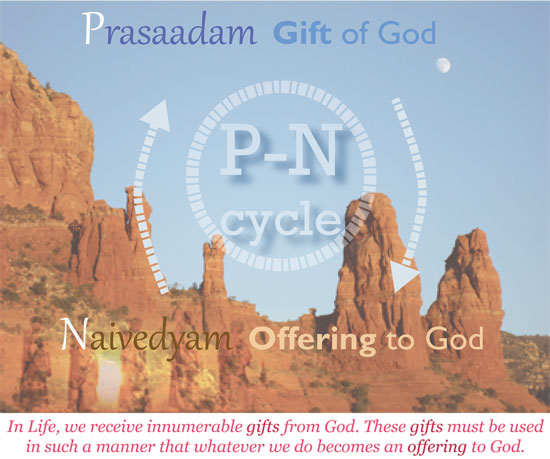 | |
KMG: Another example that Swami gives is that of Kumkum Archanam (ritualistic worship by vermillion). Bhagawan explained that Kumkum basically signifies blood and blood in turn signifies life. Thus, no blood means no life. So when a spiritual aspirant is offering Kumkum he or she is actually offering his or her own life to the Divine Mother. Here offering life means offering one's action, one's thought, word and one's will to the Divine Will. Here the act of Kumkum Archanam actually symbolises the spirit of surrender.
BP: If there is a minor in a family, the minor cannot stake claim to paternal property. It may do so only after it becomes a major. Swami says that is what Sadhana can do. Once you start doing Sadhana, once you surrender to God you have access to your true heritage. You have access to the heritage of God. Swami also says that when we say "I", we will feel alone. But when we say "Not I, but You", we will receive His grace. Then, everything shall be given to you, Baba says.
AD: I am reminded of a concept we used to discuss in our Awareness classes. This was the P and N cycle. P stands for Prasadam and N stands for Naivedyam. What we receive from God is prasadam and what we offer Him is naivedyam, which we, in turn, receive as prasadam – P-N-P. We should have this feeling that whatever we receive in life is His prasadam and that should be offered to Him as naivedyam.
GSS: I am reminded of another very good example Swami gives about surrender. He says there are two ways in which you can surrender – like that of the monkey or the cat. When a female monkey jumps from tree to tree, it's the young one which clings onto the mother's belly. It is the responsibility of the baby to cling on because as the monkey jumps from tree to tree, it does not hold on to the baby. It is the onus of the baby. But the cat, on the other hand, holds the kitten very softly in its jaws without hurting the kitten. In this case, it is the responsibility of the mother cat to hold on to the kitten. The kitten has only to relax. Swami says that of both the forms of surrender, the one of the cat is higher as you leave everything to the Lord.
AD: It's like Jnana Yoga and Bhakthi Yoga. Bhakthi Yoga is like the faith of the kitten, while in Jnana Yoga you are responsible.
GSS: I hold on and take up the responsibility. These are wonderful examples that Swami gives about surrender. And I think this is what the path of Sadhana is all about. We have seen the prerequisites to Sadhana, we have seen the process of Sadhana where we talked of Namasmarana, seeking within and ultimately all this should lead to total surrender to God because that's what life is all about. We are not the doer, we are just puppets in His hands. We should do our duty, but ultimately it is He who is doing it through us – we are just His instruments. I think it would be very apt to end this study circle talking about the critical success factors.
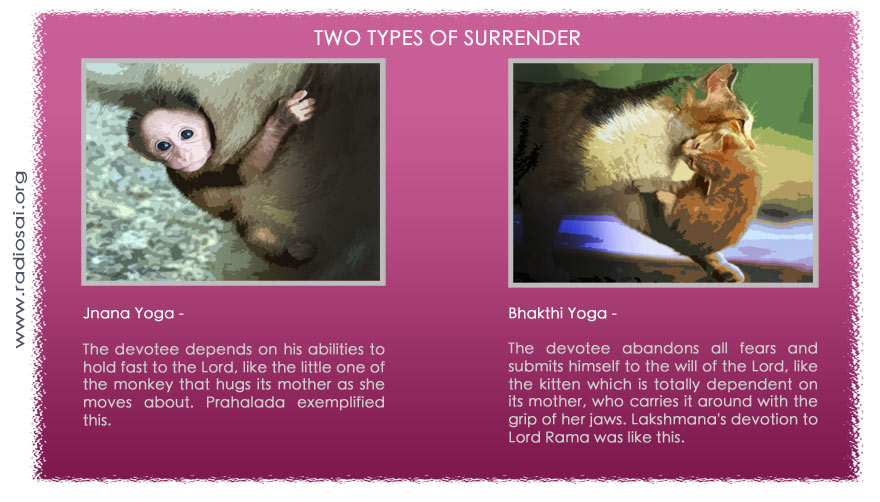 |
Sadhana is fine but what is it that will make it click? Does Swami offer any tips?
RADIO SAI STUDY CIRCLE – 8
SOS: Swami On Sadhana
SOS: Swami On Sadhana
Part 05
CRITICAL SUCCESS FACTORS FOR FRUITFUL SADHANA
KMG: Patience and perseverance are very important. Bhagawan says that there are three approaches through which an aspirant strives to reach God. The first one is the Eagle Approach. The eagle scoops down at a very high velocity towards its chosen target and grabs it quickly. Due to the speed, it may damage or even lose the target. This is what many devotees do – an overnight stunt of some Maha Yagna or sudden intense tapas.
GSS: We all are used to that.
KMG: Or the notion that some sporadic act of favour will please the Divine. This is not the path that Bhagawan prescribes. The second one is that of a monkey. The monkey has this whimsical trait of jumping from one object to other. It is not steady. It is never satisfied with one. Similarly a devotee may worship one form of God today and another one tomorrow and on the third day he stops the Sadhana. A week later he starts again. He basically lacks conviction and sturdiness just like a monkey.
GSS: You remind me of my efforts!
KMG: Most of us are reminded of ourselves. But the third and the final approach - of the ant that takes tiny, yet firm, steps of conviction towards its chosen goal. This is what Bhagawan prescribes. Only sturdy and consistent Sadhana can win the grace of the Lord.
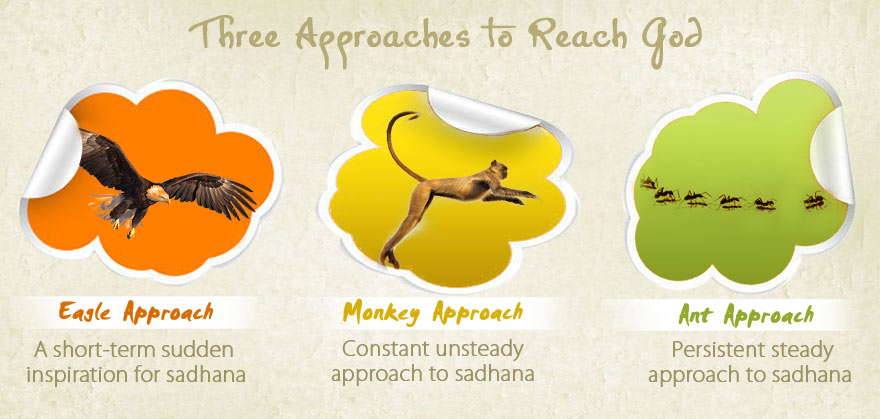 |
GSS: Wonderful!
SG: In fact Ganesh, considering the monkey example, Swami used to say it is very important that in order to find water you do not dig wells everywhere. Some people start digging at one place thinking that is the best place to find water. After about 10-15 feet they move to some other place and start digging for water again. Swami says this will only create hundreds of pits, but not wells.
Likewise, Swami extends His analogy of this well to both Guru and also the type of Sadhana. Swami says that you do not choose a Guru, rather a true Guru chooses His disciple. And after the Guru has chosen the disciple, it is the duty of the disciple, whatever may be the circumstance, to hold on strongly to that Guru.
The Guru is the one who decides what is best for you and He will tell you the right Sadhana for you as He has the bigger picture in mind. He knows exactly what is right for you and will ask you to do only that. But sometimes in our ignorance and inefficiency we question the advice of the Guru and start to look forward to dig wells in other places. This is when we encounter pitfalls in life or failure in Sadhana.
BP: Swami gives another analogy when talking about the critical success factors for Sadhana. He used to ask - why do people use a mosquito net. We use a mosquito to protect ourselves from mosquitoes. Suppose there are mosquitoes already inside the net when you tie it up?
GSS: They will bite you.
| | 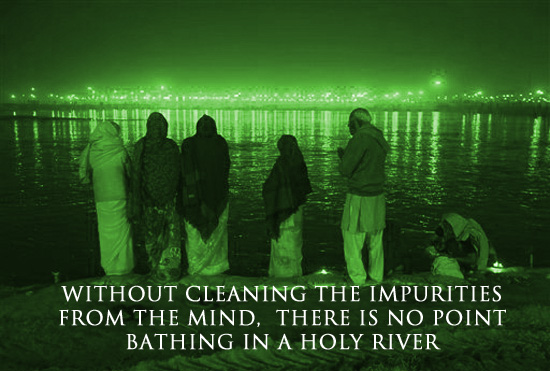 |
BP: Which is counterproductive. Swami says Sadhana is like that - if we keep on performing Sadhana such as by going to holy places and, as Ganesh mentioned, express momentary excitement with a sudden burst of intense sadhana but without cleaning the impurities from the mind, there is no point of doing Sadhana at all. If one has a lot of impurities and try to bathe in a holy river, it is of no use.
GSS: You will be polluting the river!
GSS: You will be polluting the river!
BP: Yes, it doesn't help.
KMG: Most of us who perform Sadhana live in water tight compartments. I play a role of a son, an employee, a student, a friend, a mentor, or a sportsman. I may even take a break from my job to do Seva in Prasanthi Nilayam. We are a different set of individuals depending on the type of role we take. Yes, but we fail to focus. I enjoy peace for a few minutes when I meditate. I enjoy peace when I sing bhajans. I feel expansion in my heart when I do Seva or Satsang. All this tranquillity and expansion seem to be momentary. I am unable to carry them throughout the day. It requires mindfulness and focus. How do we do that?
In the Mahabharata, Krishna tells Arjuna to fight even as he thinks of Lord Krishna. Bhagawan has explained this with a very beautiful analogy. Bhagawan has said that even as a driver is driving on a busy road he maybe talking, listening to a song or even looking behind at times, but he is always mindful of what is happening on the road. Similarly a spiritual aspirant should be mindful and carry the powerful moments of Sadhana into his work.
BP: Yes, you are correct.
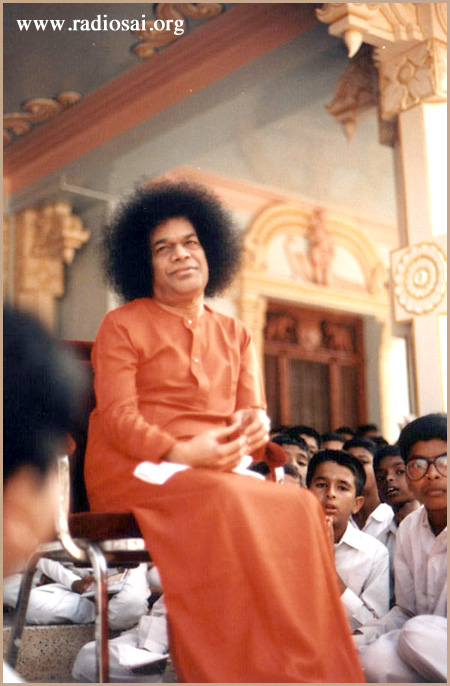 | |
KMG: Sadhana cannot be part time, it has to be full time!
BP: Absolutely. In fact talking about being careful and training the mind, Swami once said that a train moving at very high speed cannot be stopped even by a million hands, but it is possible to stop it by pressing just one button. Through that one switch you can actually stop the train. Swami says that is what Sadhana is. You have to develop the mechanism to turn inward. If you can attain that I think then you are reaching somewhere in your spiritual path.
AD: A devotee once asked, "Swami, how do I know that I am progressing in Sadhana?" Swami gave a beautiful example. He said once you sit in an airplane and when the airplane takes off do you keep looking out of the window? Don't you fully trust the pilot? Similarly all you need to do is to take the first step of getting into the flight with the Lord. Let us take that one step of faith and get into His flight. All we need to do is to just tell Him, "Swami, I am surrendering to You, You take care of my Sadhana".
BP: And not question yourself whether you are progressing or not.
GSS: I think we really have had very good tips for our Sadhana's critical success factors.
We started by stating that one's effort should not be sporadic like the eagle or unsteady like the monkey, but be steady like the ant. We also talked about partially digging in multiple places in search of water without focusing on just one spot. Bishu mentioned the example of the mosquito net and how we should not enclose ourselves in the mosquito net with mosquitoes inside.
Ganesh talked about being focused and gave the example about stopping the train with a single button. Amey very beautifully gave us the example of how we really need not look for measuring our progress because once we are confident that we are in the airplane in which Bhagawan is the pilot, everything is taken care of.
I am reminded of an incident with Bhagawan when I was a management student. Swami was very upset with us so we all gathered around Bhagawan pleading to Him saying, "Please Swami, please Swami'. What we actually meant was "Swami please talk to us".
But the 'talk' just fades away and it's just 'Please Swami, please Swami'.
And then He suddenly looked at us, He said, "What? Please Swami."
Then Swami said, "Please Swami." So we were wondering why Swami repeated what we are saying, but then Swami so beautifully pointed to us to please Him - "Please Swami."
BP: We have to please Swami.
GSS: We have to make Swami happy. Then He will talk to you. So I think the sum and substance of all this is to please God and that can be done only when you really follow and love Bhagawan.
So Sadhana is all about getting attached to God in some way through whatever means you feel is the right way for you. And be in good company because the company you are in makes a lot of difference and it is here that we can exercise some control.
Once we have done this we enter into the actual process of Sadhana, which begins with Namasmarana, but does not stop till we seek God within. And eventually we'll find ourselves reaching a state wherein we really surrender to Bhagawan and realise that it is He who does everything. This process may start with Unconscious Incompetence. Many a times one may not even be aware that he or she is on the path of Sadhana - this is Unconscious Incompetence.
Slowly we move to Conscious Incompetence by beginning to realise what we need to do – identifying the gap in our lives and the need for coming closer to God. And then we move into the stage of Conscious Competence where we realise what we are doing.
We should all progress towards that stage. Let's pray to Bhagawan that we are able to do this effectively and reach Bhagawan.
KMG: One small misconception that people may have is that those people who are engaged in Sadhana take a lot of vows and thus have a lot of obligations and burdens.
 |  |  |  |  |  |  |  |
SG: Sadhana as Sad Hona (You are sad, aren't you?).
KMG: Does this mean that a person who is engaged in Sadhana is sad? But true Sadhakas are cheerful.
GSS: Swami always says that one should not have a "Castor oil face", but should be cheerful.
KMG: Many times He has said that one should be happy. In fact being truly happy is a form of Sadhana.
KMG: Many times He has said that one should be happy. In fact being truly happy is a form of Sadhana.
BP: Happiness is what everyone wants and Sadhana is the way to attain it.
GSS: And Swami says happiness is union with God. Sadhana is the way to it.
BP: Yes!
Let us end this session with chanting the Shanthi mantra.
Om Shanthi: Shanthi: Shantihi
__._,_.___

















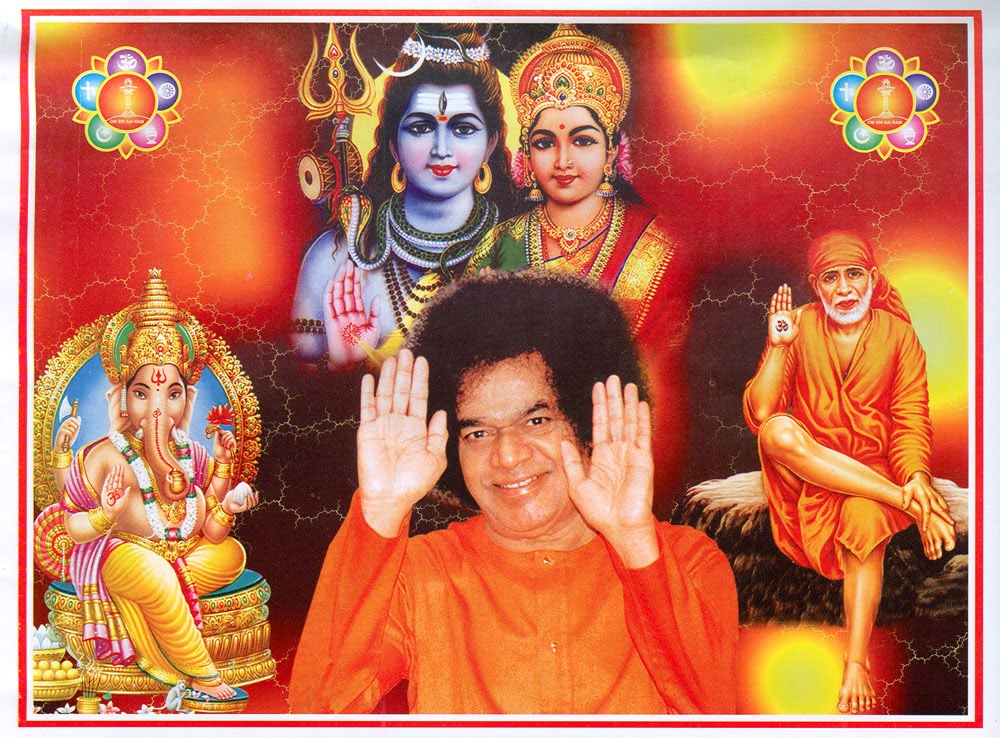







No hay comentarios :
Publicar un comentario